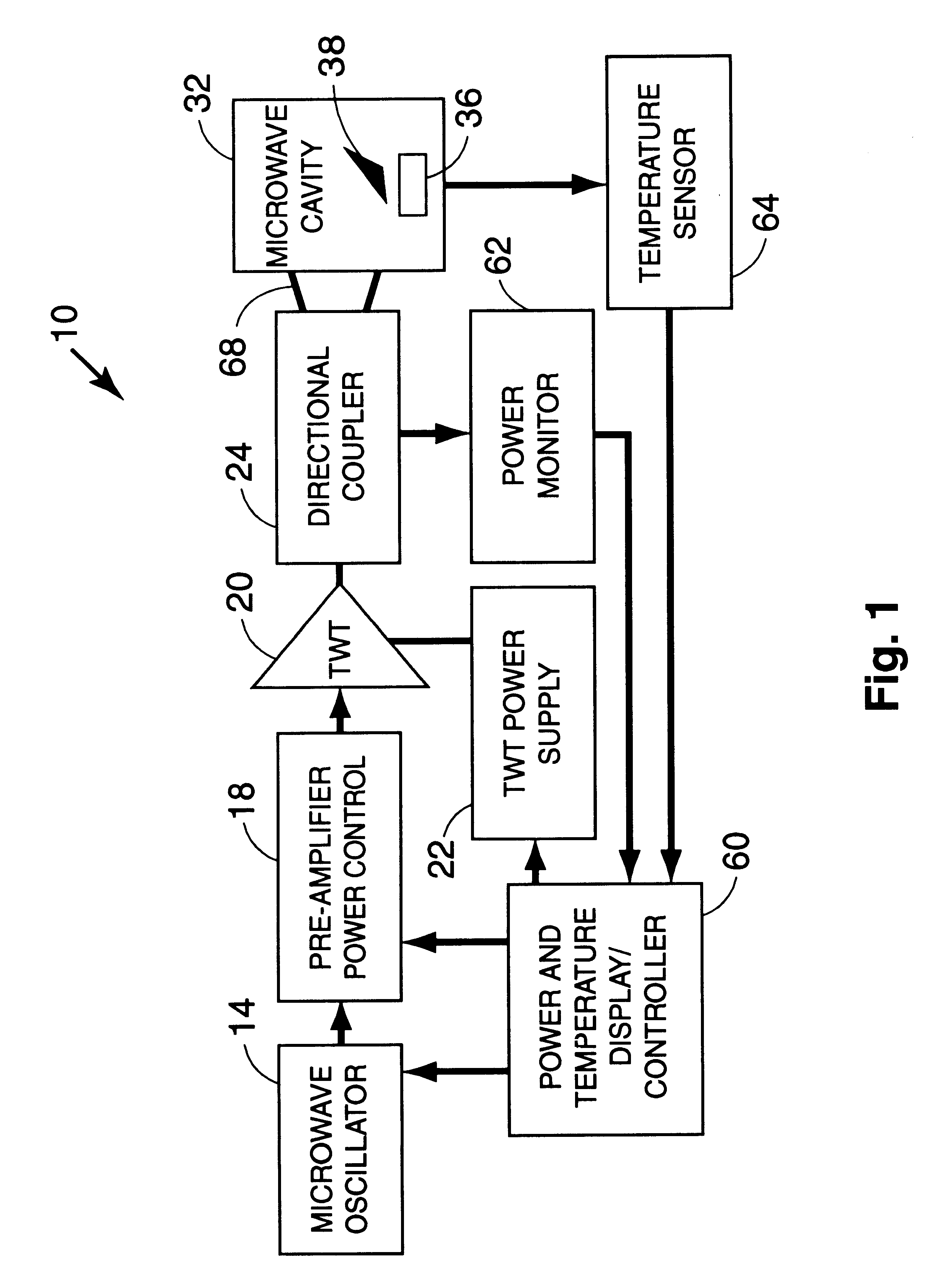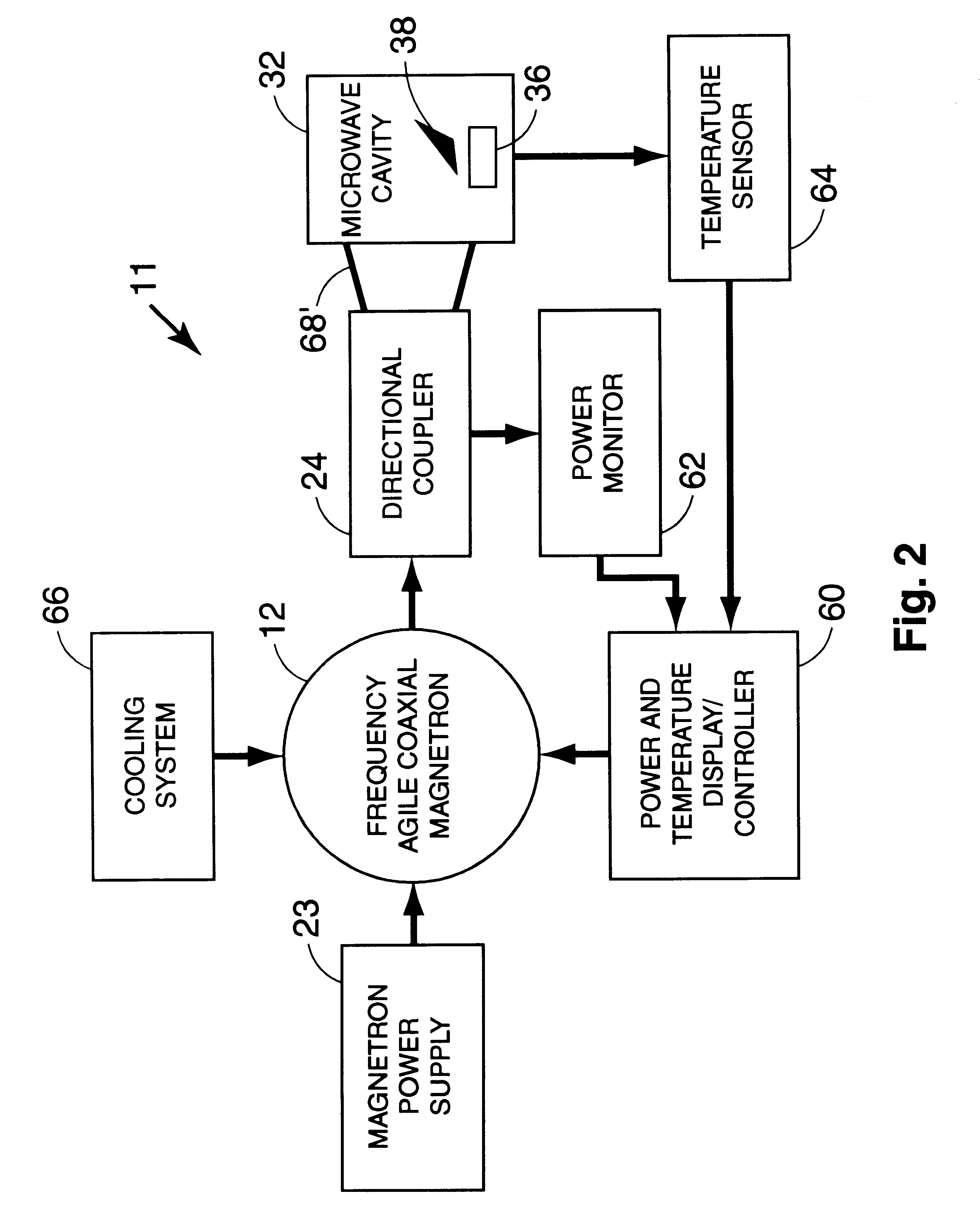Apparatus and method for microwave processing of materials using field-perturbing tool
a technology of material microwave and tool, which is applied in the direction of sustainable building, domestic cooking appliances, electric/magnetic/electromagnetic heating, etc., can solve the problems of insufficient frequency range of fixed-frequency microwave ovens typically found in the home, inability to meet the needs of microwave energy consumption, etc., to achieve the effect of reducing the power density of microwave energy and enhancing efficiency
- Summary
- Abstract
- Description
- Claims
- Application Information
AI Technical Summary
Benefits of technology
Problems solved by technology
Method used
Image
Examples
example ii
To better determine the limiting factor on required bandwidth, a theoretical model of a 13.times.12.times.10 inch rectangular microwave cavity 32 was constructed and used to determine the number of resonant modes capable of being supported in the cavity over the 4 to 6 GHz frequency range. The results of these calculations clearly demonstrate that, even in a cavity this small, there are an enormous number (over 600) of possible, closely-spaced modes (often 3 to 4 at a single frequency) over even the 4 to 6 GHz frequency range. These results have been graphically illustrated in FIG. 3 as mode density versus frequency. From these results, it is clear that a bandwidth of as little as 5% of the center frequency could, in some cases, provide sufficient mode plurality to provide relatively uniform baseline energy distribution in the microwave cavity.
Using this theoretical model, power density was calculated as a function of location at various points along a horizontal midplane of the (em...
example iii
A plasma chamber was constructed including a glass bell jar for observing the excitation of plasmas in mixtures of hydrogen and methane. The microwave source was a Microwave Laboratories, Inc. 4-8 GHz, T-1096 traveling wave tube, launching from the side into a multimode cavity. The atmosphere was about 0.9% CH.sub.4 in H.sub.2 at a pressure of about 28 torr. Steel drill bits 50 were placed in the bell jar with their tips upward and the TWT was operated at 1200 W forward power, sweeping the frequency from 4.1 to 6.7 GHz approximately 10 times per second. Surprisingly, plasmas 51 ignited stably at the tip of each drill bit as shown schematically in FIG. 5. This phenomenon occurred even with more than eight drill bits of differing sizes present in the chamber. This example illustrates how selected perturbations can be introduced into the uniform power environment of the variable frequency microwave system with predictable, controllable, and stable results. Diamond 52 can be selectively...
example iv
In a system similar to that in the preceding example, a silicon wafer 70 was placed horizontally on a pedestal as shown in cross section in FIG. 6a. Plasma 71 ignited uniformly around the periphery of the wafer, selectively depositing diamond 72 as shown. An improved setup, shown in FIG. 6b, used a field-perturbing tool 73 with a graded impedance to reduce the tendency for selective plasma discharge by equalizing the electric field in the vicinity of the wafer 70.
The field-perturbing tool 73 comprises an alumina base layer 74, an alumina-silicon carbide intermediate layer 75, and a silicon carbide top layer 76.
The field-perturbing 73 tool illustrated in FIG. 6b was constructed as a demonstration of the potential of the field-perturbing tool and associated method to equalize the power distribution around a workpiece containing a physical discontinuity as illustrated theoretically in FIG. 14. Skilled artisans will appreciate that the technique could be used to create even more optimal...
PUM
| Property | Measurement | Unit |
|---|---|---|
| frequency | aaaaa | aaaaa |
| frequencies | aaaaa | aaaaa |
| frequency | aaaaa | aaaaa |
Abstract
Description
Claims
Application Information
 Login to View More
Login to View More - R&D
- Intellectual Property
- Life Sciences
- Materials
- Tech Scout
- Unparalleled Data Quality
- Higher Quality Content
- 60% Fewer Hallucinations
Browse by: Latest US Patents, China's latest patents, Technical Efficacy Thesaurus, Application Domain, Technology Topic, Popular Technical Reports.
© 2025 PatSnap. All rights reserved.Legal|Privacy policy|Modern Slavery Act Transparency Statement|Sitemap|About US| Contact US: help@patsnap.com



